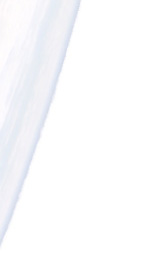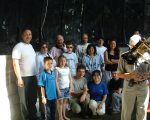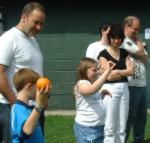


Sunspotting - 2003
One sunny, summer Saturday morning at Clanfield Observatory in Hampshire, England, Cosmos Education UK greeted visitors wishing to learn more about the Sun, and our Solar System. We organised the event for three reasons:
- To increase interest in and awareness of Science
- To promote the work of Cosmos Education
- As ground work before setting up our Schools Network in the UK
After introducing ourselves and Cosmos Education we headed outside to give everyone the opportunity to see more of the Sun than we normally can. Looking directly at the sun, especially through binoculars or a telescope, is absurdly dangerous. You can easily permanently blind yourself. Do not do it! We used professional equipment to make it safe.
The first method used was projection: A telescope was adapted to project an image onto a white background in a dark box. This provided a spectacular picture of the Sun about a foot across, clearly displaying several dark patches: Sun Spots!
 Next we went into
the observatory dome where the Hampshire Astronomical Group told us a little about the telescope
there. The key fact for our purposes was that it was fitted with a Hydrogen
Alpha filter - an expensive bit of kit which cuts down the light from the sun to
a level at which it can safely be viewed.
Next we went into
the observatory dome where the Hampshire Astronomical Group told us a little about the telescope
there. The key fact for our purposes was that it was fitted with a Hydrogen
Alpha filter - an expensive bit of kit which cuts down the light from the sun to
a level at which it can safely be viewed.
Looking through this special telescope we were able to see part of the Sun. For the most part a dark red, parts of the surface were obscured by dark dots and lines. Although a few of these were dust on the lenses, most were sunspots and filaments (streams of gas ejected from the surface of the sun which are cooler and therefore appear dark.) We were also lucky to see a chevron of red a "little" distance off the main disc of light. This was a flare which had been thrown out to a distance of some 70,000 kilometers - around 10 Earth radii.
Back inside the society's building, our guests were treated to a presentation on the Sun. Will Clarkson described the structure of the Sun, how it varies and how it affects the Earth. He also explained some of the structure we'd been able to see through the telescope and viewer. The reason that sunspots are clearly visible, we were told, is that they are much cooler than most of the surface. The flare we saw was hot plasma but nobody currently understands the cause of these phenomena.
Heading outside again, we
used a demonstration of the sort we use when teaching children on the Under African Skies Expeditions.  As so many of the numbers in science
(particularly in astronomy) are so large, we wished to give a sense of scale. Using an orange to
represent the Sun, Jupiter became a small grape and Earth, a grain of sand! One of our younger
visitors correctly estimated the scaled distance at which the "Earth" should be held from the orange
(around 10 metres) and another had to be encouraged to the end of the field (about 60 metres away)
with "Jupiter". We decided to leave this demonstration at this point as Pluto would have been a
speck of dust about a quarter of a mile away. The only extension we allowed was to point out that
with another orange to represent the nearest star to the Sun, it would have to
be about 5,000 kilometres away - most of the way to the centre of our
planet!
As so many of the numbers in science
(particularly in astronomy) are so large, we wished to give a sense of scale. Using an orange to
represent the Sun, Jupiter became a small grape and Earth, a grain of sand! One of our younger
visitors correctly estimated the scaled distance at which the "Earth" should be held from the orange
(around 10 metres) and another had to be encouraged to the end of the field (about 60 metres away)
with "Jupiter". We decided to leave this demonstration at this point as Pluto would have been a
speck of dust about a quarter of a mile away. The only extension we allowed was to point out that
with another orange to represent the nearest star to the Sun, it would have to
be about 5,000 kilometres away - most of the way to the centre of our
planet!
Space is big.
We finished the morning's presentations with more detail on the Sun (including some videos) and a reminder that our Sun is pretty much like most of the other 200 billion or so in our galaxy.
We would like to thank Hampshire Astronomical Group for its help in running the day and the use of its facilities, and Tony Jenkins for photography. Our thanks also to those who came on the day; we hope you enjoyed it! If anyone reading this would be interested in seeing more short days of science, not necessarily astronomy, please write to us at CLo@cosmoseducation.org. Similarly, if you think you may be able to offer help, whether with facilities, scientific equipment which could be donated to African Schools, old science text books, money to help finance the work we do in developing countries, or with your time, then please contact us at the same address.
The following links are to external sites which we believe may be of interest, but for which we are not responsible
In Kenya, Cosmos Education Kenya is Registered Society No. 26710.
In the United States, Cosmos Education is a Project of The Tides Center, a 501(c)3 non‑profit organisation.
In England and Wales, Cosmos Education UK is Registered Charity No. 1100278
Cosmos Education Zambia is registered under the Societies Act in the Republic of Zambia, Registration No. ORS/102/35/3017.